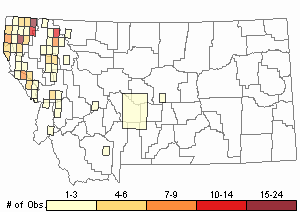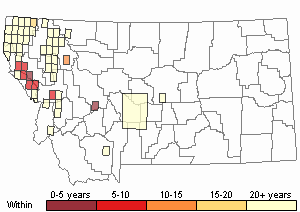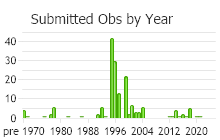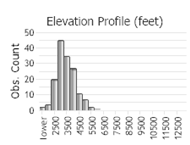View in other NatureServe Network Field Guides
NatureServe
Montana
Utah
Wyoming
Idaho
Wisconsin
British Columbia
South Carolina
Yukon
California
New York
Frightened Cat-tail Moss - Rhytidiadelphus triquetrus
Other Names:
Gooseneck Moss
General Description
Plants: Pleurocarpous (Vitt 1988), growing in open mats (Crum and Anderson et al. 1981), somewhat rough, to 20 cm in length (FNA 2014), green or green with yellow tones (Lawton 1971), deeply- or brightly-colored (Crum and Anderson et al. 1981). Stems creeping or ascending (Lawton 1971), main stems growing indefinitely with perichaetia and perigonia lateral, erratically- to equally-pinnate; branches sometimes reaching 25 mm in length (FNA 2014), frequently bowed and curving downward (Crum and Anderson et al 1981); paraphyllia lacking; pseudoparaphyllia leaf-like (FNA 2014).
Stem Leaves: Closely spaced, creating rosettes, near the stem and branch ends (Lawton 1971), spreading broadly to upright, wet or dry (Crum and Anderson et al. 1981), not all pointing in one direction, 3.2-4.9 mm in length, sometimes reaching 2.5 mm in width, pleated below, deltoid and with ovate tendencies from a heart-shaped base that hugs the stem, tapering slowly to a wide acumen; acumen plane, occasionally transversely wavy (FNA 2014); leaf edges flat, with numerous serrations above, the serrations finer and more distantly-spaced from about mid-leaf to the base (Crum and Anderson et al. 1981); costa double, about half to less than 3/4 of the leaf length (FNA 2014).
Branch Leaves: Egg- to lance-shaped, shorter (to 3.1 mm in length) and narrower than the stem leaves (FNA 2014).
Leaf Cells: Distal cells oblong and very slender to linear, roughly-toothed or papillose abaxially and with scattered, more delicate papillae adaxially, in both cases from protruding cell ends (Crum and Anderson et al. 1981), longer and narrower than the basal cells, the walls a little porose; basal laminal cells frequently with some color, porose and with thicker walls than the medial cells (Lawton 1971); alar cells only a little distinct from adjacent cells (FNA 2014).
Diagnostic Characteristics
The robust double costa and sizeable papillae formed by the projecting cell ends are diagnostically helpful (Crum and Anderson et al. 1981).
Range Comments
North American Range
Canada: Known in all provinces and territories except NU; USA: AK, WA to CA and AZ, ID, MT to CO, SD, MN to AR and east from there to the coastal states (from ME s to NC, except KY) (FNA 2014). Known in Montana from Fergus, Flathead, Gallatin, Glacier, Granite, Lake, Lincoln, Mineral, Missoula, Park, Ravalli, and Sanders Counties (Elliott and Pipp 2016).
Observations in Montana Natural Heritage Program Database
Number of Observations: 205
(Click on the following maps and charts to see full sized version)
Map Help and Descriptions
Relative Density

Recency



 (Observations spanning multiple months or years are excluded from time charts)
(Observations spanning multiple months or years are excluded from time charts)
Habitat
Soil, organic soil, decayed organic matter (FNA 2014), litter (Lawton 1971), not as common on stone and rotting wood, in evergreen forests (FNA 2014) and often in open areas of woods (Crum and Anderson et al. 1981). Occurring from lowlands to 6560 feet (FNA 2014).
Reproductive Characteristics
Dioicous with female plants resembling male plants. Perigonia sometimes brownish. Seta 25-40 mm tall (Lawton 1971), smooth. Capsule level, sometimes reaching 3.5 mm in length (FNA 2014), russet, creased or pleated when dry; exostome russet (Lawton 1971) with transverse fine lines or a network of them below; endostome processes with wide openings on the keel. Calyptra draping, cowl-like, smooth and hairless (FNA 2014).
Stewardship Responsibility
References
- Literature Cited AboveLegend:
 View Online Publication
View Online Publication Crum, H.A. and L.E. Anderson. 1981. Mosses of Eastern North America. 2 volumes. Columbia University Press, New York. 1328 pp.
Crum, H.A. and L.E. Anderson. 1981. Mosses of Eastern North America. 2 volumes. Columbia University Press, New York. 1328 pp. Elliott, J.C. and A.K. Pipp. 2018. A Checklist of Montana Mosses (1880-2018). Updated 3 January, 2020. Montana Natural Heritage Program, Helena, Montana. 73 pp.
Elliott, J.C. and A.K. Pipp. 2018. A Checklist of Montana Mosses (1880-2018). Updated 3 January, 2020. Montana Natural Heritage Program, Helena, Montana. 73 pp. Flora of North America Editorial Committee, eds. 2014. Flora of North America North of Mexico. Volume 28. Bryophytes: Mosses, Part 2. Oxford University Press, Inc., NY. xxi + 702 pp.
Flora of North America Editorial Committee, eds. 2014. Flora of North America North of Mexico. Volume 28. Bryophytes: Mosses, Part 2. Oxford University Press, Inc., NY. xxi + 702 pp. Lawton, E. 1971. Moss Flora of the Pacific Northwest. Hattori Botanical Laboratory. Japan: Yamabuki-cho, Shinjuku-ku, Tokyo. 362 pages plus appendices.
Lawton, E. 1971. Moss Flora of the Pacific Northwest. Hattori Botanical Laboratory. Japan: Yamabuki-cho, Shinjuku-ku, Tokyo. 362 pages plus appendices. Vitt, D. J. Marsh, and R. Bovey. 1988. Mosses, Lichens & Ferns of Northwest North America. Seattle, WA: University of Washington Press. 296 p.
Vitt, D. J. Marsh, and R. Bovey. 1988. Mosses, Lichens & Ferns of Northwest North America. Seattle, WA: University of Washington Press. 296 p.
- Additional ReferencesLegend:
 View Online Publication
View Online Publication
Do you know of a citation we're missing? Elliot, J. C. 1993. Second checklist of Montana mosses. Unpublished report. U.S. Forest Service, Region 1. Missoula, MT. 45 pp.
Elliot, J. C. 1993. Second checklist of Montana mosses. Unpublished report. U.S. Forest Service, Region 1. Missoula, MT. 45 pp. Lawton, E. 1971. Keys for the Identification of the Mosses on the Pacific Northwest. Reprinted from 'Moss Flora of the Pacific Northwest'. Published as Supplement No. 2 of the Journal of the Hattori Botanical Laboratory. Nichinan, Miyazaki, Japan. 66 pp.
Lawton, E. 1971. Keys for the Identification of the Mosses on the Pacific Northwest. Reprinted from 'Moss Flora of the Pacific Northwest'. Published as Supplement No. 2 of the Journal of the Hattori Botanical Laboratory. Nichinan, Miyazaki, Japan. 66 pp.
- Web Search Engines for Articles on "Frightened Cat-tail Moss"





